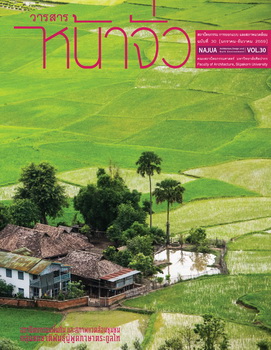การวิเคราะห์ใหม่: สถาปัตยกรรมพระบรมธาตุไชยา จังหวัดสุราษฎร์ธานี
Keywords:
เศรษฐศาสตร์วัฒนธรรม, จามปา, ศรีวิชัย, ไชยา, Cultural Economics, Champa, Srivijaya, ChaiyaAbstract
พระบรมธาตุไชยา จังหวัดสุราษฎร์ธานี ได้รับการยกย่องว่าเป็นสถาปัตยกรรมศรีวิชัยเพียงแห่งเดียวของไทยที่ยังคงความสมบูรณ์และงดงามที่สุด แม้ไม่มีหลักฐานว่าอาคารดังกล่าวสร้างขึ้นในสมัยใดหรือผ่านการซ่อมแปลงมาแล้วกี่ครั้ง แต่ด้วยองค์ประกอบสำคัญทางสถาปัตยกรรม อันได้แก่ “สถูปเจดีย์” ที่ประดับอยู่บนชั้นหลังคาแต่ละชั้น เช่นเดียวกับที่พบใน “จันทิ” สถาปัตยกรรมศรีวิชัยของราชวงศ์ไศเลนทร์ในชวาภาคกลาง ประเทศอินโดนีเซีย จึงเกิดข้อสรุปในทางวิชาการตรงกันว่า พระบรมธาตุไชยาถูกสร้างขึ้นด้วยศิลปะศรีวิชัยในพุทธศตวรรษที่ 14-15 ซึ่งเป็นช่วงเวลาเดียวกับที่มีการก่อสร้างสถาปัตยกรรมวัดเวียง วัดหลงและวัดแก้ว เมืองไชยา จังหวัดสุราษฎร์ธานีและจันทิกะลาสัน ชวาภาคกลาง ประเทศอินโดนีเซีย ในการศึกษานี้จะชี้ให้เห็นว่า “พระบรมธาตุไชยา” น่าจะถูกสร้างขึ้นครั้งแรกตั้งแต่ประมาณพุทธศตวรรษที่ 12-13 ด้วยรูปแบบศิลปะจามแห่งอาณาจักรจามปา และสันนิษฐานว่าต่อมาได้ถูกปรับแปลงใหม่ในช่วงพุทธศตวรรษที่ 14-15 ภายใต้ความสัมพันธ์กับวัฒนธรรมศรีวิชัย โดยเพิ่มองค์ประกอบที่เป็นสถูปเจดีย์บนชั้นหลังคาทุกชั้นรวมทั้งบนยอดสูงสุดของอาคาร เหตุการณ์ดังกล่าวเป็นช่วงเวลาเดียวกับที่มีการก่อสร้างสถาปัตยกรรมวัดเวียง วัดหลง และวัดแก้ว บนพื้นที่เมืองไชยา
นอกจากนี้ เมื่อทำการศึกษารูปแบบสถาปัตยกรรมของพระบรมธาตุไชยา ด้วยวิธีวิทยาทางประวัติศาสตร์สถาปัตยกรรม ควบคู่ไปกับการศึกษาหลักฐานด้านอื่นๆ อาทิ จารึก จดหมายเหตุจากจีน และศิลปวัตถุ ผ่านกรอบความคิดของทฤษฎีเศรษฐศาสตร์วัฒนธรรม ได้นำมาสู่ข้อสันนิษฐานใหม่เกี่ยวกับประวัติศาสตร์ศรีวิชัยในเมืองไชยาว่า “ก่อนที่ไชยาจะเป็นส่วนหนึ่งของวัฒนธรรมศรีวิชัยในพุทธศตวรรษที่ 14 นั้น พื้นที่แห่งนี้น่าจะเคยได้รับอิทธิพลทางวัฒนธรรมจากอาณาจักรจามปามาก่อน โดยมีหลักฐานคือพระบรมธาตุไชยาก่อนที่จะถูกซ่อมแปลงในสมัยที่ร่วมกับวัฒนธรรมศรีวิชัย เป็นประจักษ์พยานสำคัญ”
Rethinking Architecture of Chedi at Phra Borommadhat Chaiya
Waraporn Suwattanachotikul
Master of Arts in History of Architecture, Faculty of Architecture, Silpakorn University
Saner Nildej
Faculty of Architecture, Silpakorn University
Chotima Jaturawong
Faculty of Architecture, Silpakorn University
Phra Borommadhat Chaiya in Surat Thani is renowned for being the only Srivijayan architecture in Thailand that is left in perfect condition and is considered the most elegant. Although there is no evidence of when it was actually first constructed or how many times it had undergone renovations, its important architectural feature, which is the stupas adorning each tier of the structure, and found to be similar to that of “Candi” (Srivijayan architecture during Sailan Dynasty in Central Java, Indonesia), has led to the conclusion that it was built in Srivijayan style during the 8th-9th century. This was the same period in which Wat Wieng, Wat Long and Wat Kaeo were built in Chaiya, Surat Thani, and Candi Kalasan in Central Java of Indonesia. This article therefore speculates that Phra Borommadhat Chaiya could have been first built around 6th-7th century in Champa style and later renovated in the 8th-9th centuries under the influence of Srivijayan culture, when the small stupas were added to each tier level up to the topmost part of the structure, in the same period as the construction of Wat Wieng, Wat Long and Wat Kaeo in Chaiya.
In addition to that, from studying the architecture of Phra Borommadhat Chaiya through historical and scientific methods along with other evidences such as inscriptions, Chinese archival documents and art objects, based on principles of cultural economics, a new supposition about the history of Srivijaya in Chaiya has been raised suggesting that before Chaiya became part of Srivijayan civilization in the 8th century, the region was likely to have been under the influence of Champa culture. This is revealed through evidence of the existence of Phra Borommadhat Chaiya before it underwent renovation during the Srivijaya period.





